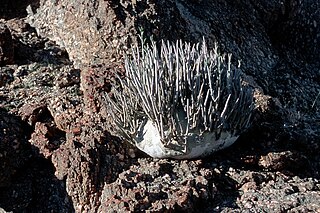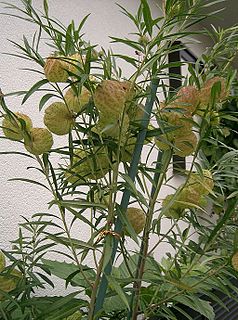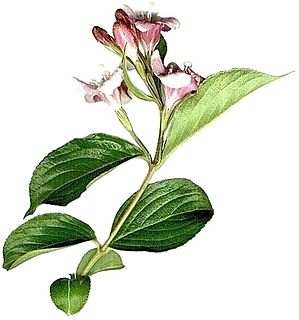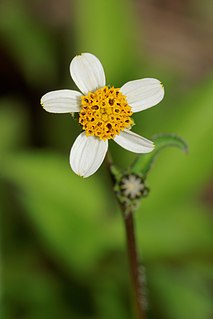
Adenia is a genus of flowering plants in the passionflower family, Passifloraceae. It is distributed in the Old World tropics and subtropics. The centers of diversity are in Madagascar, eastern and western tropical Africa, and Southeast Asia. The genus name Adenia comes from "aden", reported as the Arabic name for the plant by Peter Forsskål, the author of the genus.

Acokanthera is a genus of flowering plants in the family Apocynaceae. It comprises 5 species and is generally restricted to Africa, although Acokanthera schimperi also occurs in Yemen. Its sap contains the deadly cardiotoxic glycoside ouabain. The sap is among the most commonly used in arrow poisons, including those used for poaching elephant.

Momordica balsamina is a tendril-bearing annual vine native to the tropical regions of Africa, introduced and invasive in Asia, Australia, Central America, and North America, where they have been found in some parts of Florida. It has pale yellow, deeply veined flowers and round, somewhat warty, bright orange fruits, or "apples". When ripe, the fruits burst apart, revealing numerous seeds covered with a brilliant scarlet, extremely sticky coating. The balsam apple was introduced into Europe by 1568 and was used medicinally to treat wounds. In 1810, Thomas Jefferson planted this vine in his flower borders at Monticello along with larkspur, poppies, and nutmeg.

Abelmoschus caillei, the West African okra, is a plant species in the family Malvaceae. It occurs in humid areas of West and Central Africa, where it is used as a vegetable. It originated as an allopolyploid hybrid of Abelmoschus esculentus and A. manihot, and is often mistaken for either of those two plants. It was officially described elevated to the status of a species in 1988. The same hybrid was produced experimentally in Japan where it is known as Abelmoschus glutino-textile.

Gomphocarpus physocarpus, commonly known as hairy balls, balloonplant, balloon cotton-bush, bishop's balls, nailhead, or swan plant, is a species of milkweed. The plant is native to southeast Africa, but it has been widely naturalized. It is often used as an ornamental plant.

Plant Resources of Tropical Africa, known by its acronym PROTA, is an international programme concerned with making scientific information about utility plants accessible in Africa, supporting their sustainable use to reduce poverty.

Acalypha bipartita is a species in the botanical family Euphorbiaceae. It occurs widely in Africa where it is eaten as a vegetable, or fed to animals. The leaves are considered nutritious, as they contain a high concentration of calcium. It is often found as undergrowth in the forest, on the edges of the forest, and in wooded grasslands, particularly in Sudan, Uganda, Kenya, eastern Zaire, Burundi, Rwanda, and Tanzania. The stems are often used in making baskets.

Barleria obtusa, the bush violet, occurs naturally along forest margins in the summer rainfall region of South Africa. It is widely cultivated as a decorative garden shrub.

Bidens pilosa is an annual species of herbaceous flowering plant in the daisy family Asteraceae. Its many common names include black-jack, beggarticks, farmer’s friends and Spanish needle, but most commonly referred to as cobblers pegs. It is native to the Americas but is widely distributed as an introduced species in other regions worldwide including Eurasia, Africa, Australia, South America and the Pacific Islands.

Acokanthera schimperi, belonging to the family Apocynaceae, is a small tree native to eastern and central Africa as well as to Yemen.

Acalypha indica is an herbaceous annual that has catkin-like inflorescences with cup-shaped involucres surrounding the minute flowers. It is mainly known for its root being attractive to domestic cats, and for its various medicinal uses. It occurs throughout the Tropics.

Adenium boehmianum, the Bushman poison, is a poisonous succulent endemic to the mostly dry regions of northern Namibia and southern Angola. The San people boil the root sap and latex to prepare arrow poison, which is sufficient for hunting large mammals, as it contains strong cardiotoxic effects. The leaves, borne only for three months a year, are arranged spirally and are clustered near the branch tips. A plant will flower for only a few weeks in winter. The oblong fruit releases many seeds through a longitudinal slit, which due to their lateral tufts, can be dispersed by wind.

Acalypha fruticosa is a species of flowering plant in the botanical family Euphorbiaceae. It occurs widely in East and southern Africa where it is eaten as a vegetable. It is also an important browse plant for sheep. In East Africa and southern Africa it is used as a medicinal plant. In northern Kenya arrow shafts and beehive lids are made from the stem. From the dried leaves a tea is made in Ethiopia.
Acalypha integrifolia is a species of flowering plant in the botanical family Euphorbiaceae. It is locally used as a medicinal plant. Leaf decoctions are drunk to treat intestinal worms.
Acalypha ornata is a species in the botanical family Euphorbiaceae. In Africa it is widely used as a medicinal plant. The stems are used as fibres for weaving baskets. The leaves are eaten as a vegetable; the plants are also fed to domestic animals. Acalypha ornata is sometimes planted as an ornamental plant.
Acalypha psilostachya is a species in the botanical family Euphorbiaceae. In East Africa it is used as a medicinal plant.

Acalypha villicaulis is a species in the botanical family Euphorbiaceae. In tropical Africa it is widely used as a medicinal plant.

Aloe buettneri is a species of succulent plant in the family Asphodelaceae. It is found in West Africa and is known for its medicinal uses.

Boerhavia erecta, commonly known as the erect spiderling or the erect boerhavia, is one of more than 100 species in the genus Boerhavia L. Boerhavia erecta is native to the United States, Mexico, Central America and western South America, but now is cosmopolitan in tropical and subtropical regions. In Africa its distribution extends from West Africa, eastwards to Somalia and down to South Africa. It has recently been found in parts of Madagascar and Réunion. In Asia, it occurs in India, Java, Malaysia, the Philippines, China and the Ryukyu Islands.

Adenia globosa is a species of flowering plant in the passionflower family, Passifloraceae. It is native to tropical Africa, where it occurs in Ethiopia, Kenya, Somalia, and Tanzania. It is known as mpaga in Swahili.

















